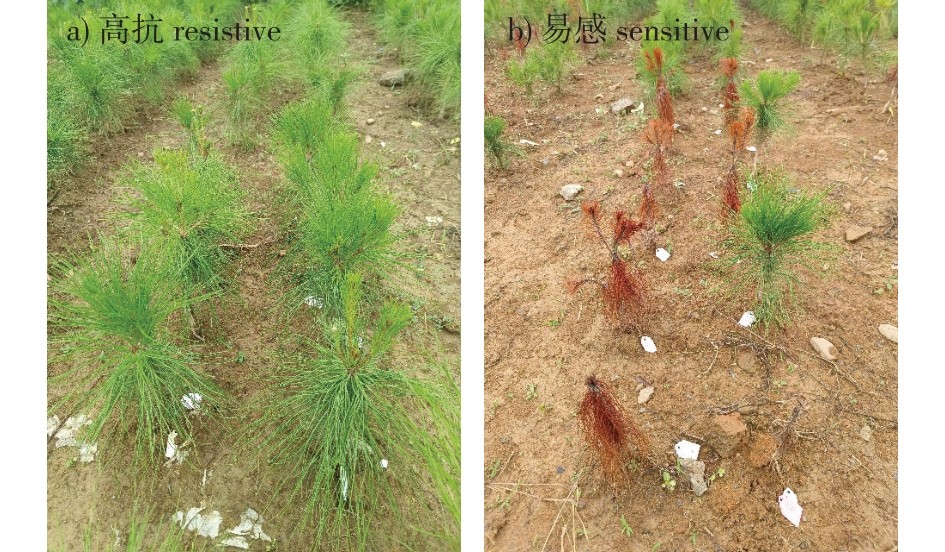 PDF(4430 KB)
PDF(4430 KB)


马尾松抗病种质资源筛选与基于液相芯片的SNP初步分析
朱静一, 刘青华, 周志春, 汪阳东, 骆定会
南京林业大学学报(自然科学版) ›› 2025, Vol. 49 ›› Issue (5) : 1-10.
 PDF(4430 KB)
PDF(4430 KB)
 PDF(4430 KB)
PDF(4430 KB)
马尾松抗病种质资源筛选与基于液相芯片的SNP初步分析
Screening of disease-resistant germplasm resources of Pinus massoniana and preliminary SNP analysis based on liquid chip
【目的】马尾松(Pinus massoniana)是中国南方山地的乡土树种,具有重要的经济和生态价值。随着松材线虫病的入侵,开展抗松材线虫病马尾松的选育,为马尾松的抗病育种提供优良家系材料日益重要。【方法】以5个松材线虫病较严重的省(区)马尾松林的51个抗性优树的725株1年生半同胞子代为材料,通过人工接种5 000条松材线虫进行家系抗性评价。将接种抗病表型数据结合马尾松101.6 K液相探针靶向测序数据进行全基因组关联分析(GWAS)。【结果】共筛选到4个高抗家系和10个中抗家系,作为马尾松优良抗病种质资源。混合线性模型(MLM)共得到5个显著SNP位点,总计表型解释率7.69%~11.24%;一般线性模型(GLM)共得到4个显著SNP位点,总计表型解释率5.96%;BLINK模型共得到11个显著SNP位点,总计表型解释率12.86%~26.43%。这些显著SNP位点共关联9个功能基因,包含P450蛋白家族,果胶甲酯酶抑制蛋白(PMEIs)等功能基因。这些基因可能通过影响细胞壁结构、细胞膜上特异蛋白识别等方式帮助树体调控松材线虫入侵后的免疫反应。【结论】选育的14个抗性家系可作为马尾松抗病育种优良家系材料,关联分析筛选得到9个抗病侯选基因,为解析马尾松抗病机理和实现抗病马尾松早期选择奠定基础。
【Objective】Pinus massoniana (masson pine), a native conifer species endemic to southern China’s mountainous regions, holds significant economic and ecological value. However, the spread of pine wood nematode disease (PWD) has necessitated breeding programs to enhance its resistance, and to provide critical germplasm for PWD-resistant breeding. 【Method】A total of 725 half-sib progenies (from 51 families) derived from PWD-resistant P. massoniana trees were collected across five provinces (cautonomous region). Resistance was assessed via artificial inoculation with 5 000 pine wood nematodes per seedling. Genome-wide association studies (GWAS) were performed by integrating phenotypic data from inoculation assays with targeted sequencing data generated using a 101.6 K liquid-phase probe panel. 【Result】Four highly resistant and ten resistant families were identified as valuable germplasm resources. Statistical analyses revealed that mixed linear model (MLM) obtained five significant SNPs (phenotypic variance explained, PVE 7.69%-11.24%). General linear model (GLM) obtained four significant SNPs (total PVE 5.96%). BLINK model obtained eleven significant SNPs (PVE 12.86%-26.43%). Nine candidate genes were functionally annotated, including P450 family proteins, pectin methylesterase inhibitors (PMEIs), and others. These genes likely regulate post-invasion immune responses by modulating cell wall structure and membrane protein recognition. 【Conclusion】Fourteen P. massoniana resistant families can serve as valuable breeding materials for disease-resistant varieties. Nine candidate disease-resistant genes identified through GWAS will contribute to elucidating the disease resistance mechanisms of P. massoniana and facilitating early selection of disease-resistant varieties.

masson pine(Pinus massoniana) / pine wilt disease (PWD) / genome-wide association study / resistance genes
| [1] |
季孔庶, 王章荣, 陈天华, 等. 马尾松扦插繁殖年龄效应及继代扦插复壮效果[J]. 浙江林学院学报, 1999, 16(4):341-345.
|
| [2] |
孙永春. 南京中山陵发现松材线虫[J]. 江苏林业科技, 1982, 9(4):47-27.
|
| [3] |
叶建仁. 松材线虫病在中国的流行现状、防治技术与对策分析[J]. 林业科学, 2019, 55(9):1-10.
|
| [4] |
徐将. 松材线虫病疫木就地覆盖熏蒸除害处理技术研究[J]. 现代农业科技, 2017(12):150-151.
|
| [5] |
颜学武. 花绒寄甲人工饲料及林间应用技术研究[D]. 南京: 南京林业大学, 2014.
|
| [6] |
陈元生, 黄燕洪, 周满生. 松材线虫病疫木伐桩除害处理技术概述[J]. 林业科技开发, 2014, 28(1): 12-14.
|
| [7] |
|
| [8] |
|
| [9] |
|
| [10] |
|
| [11] |
|
| [12] |
|
| [13] |
|
| [14] |
|
| [15] |
|
| [16] |
|
| [17] |
|
| [18] |
|
| [19] |
徐六一, 户田忠雄. 马尾松松材线虫抗性候补木的选拔及评价研究[J]. 安徽农业科学, 2006, 34(17):4303-4304.
|
| [20] |
|
| [21] |
|
| [22] |
|
| [23] |
|
| [24] |
|
| [25] |
|
| [26] |
|
| [27] |
|
| [28] |
|
| [29] |
|
| [30] |
|
| [31] |
|
| [32] |
|
| [33] |
|
| [34] |
徐六一. “抗松材线虫病马尾松种源及抗性育种技术研究” 通过验收[J]. 安徽林业科技, 2015, 41(3):20.
|
| [35] |
郝焰平, 徐六一, 姜春武, 等. 安徽省适生马尾松优良种源子代抗松材线虫病评价及生长性状研究[J]. 江西农业学报, 2019, 31(3):41-45.
|
| [36] |
|
| [37] |
|
| [38] |
|
| [39] |
|
| [40] |
|
| [41] |
宣云, 赵竑绯, 郭肖颖, 等. 植物细胞壁重构酶木葡聚糖内转糖苷酶/水解酶(XTH)的研究进展[J]. 中国农学通报, 2016, 32(18):83-88.
|
| [42] |
|
| [43] |
|
| [44] |
|
/
| 〈 |
|
〉 |